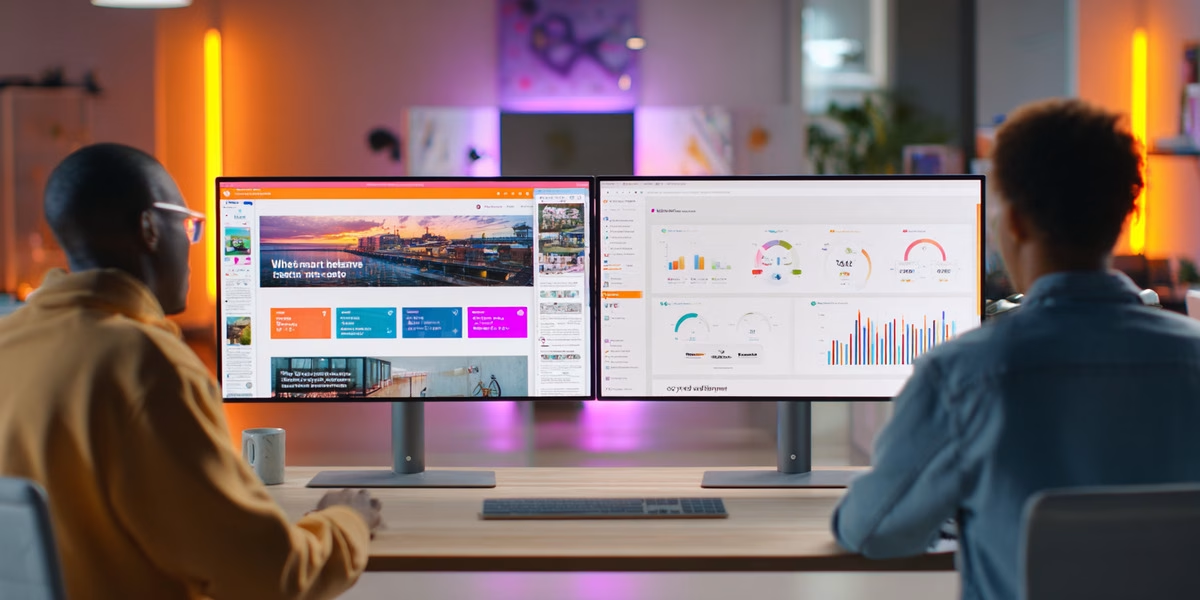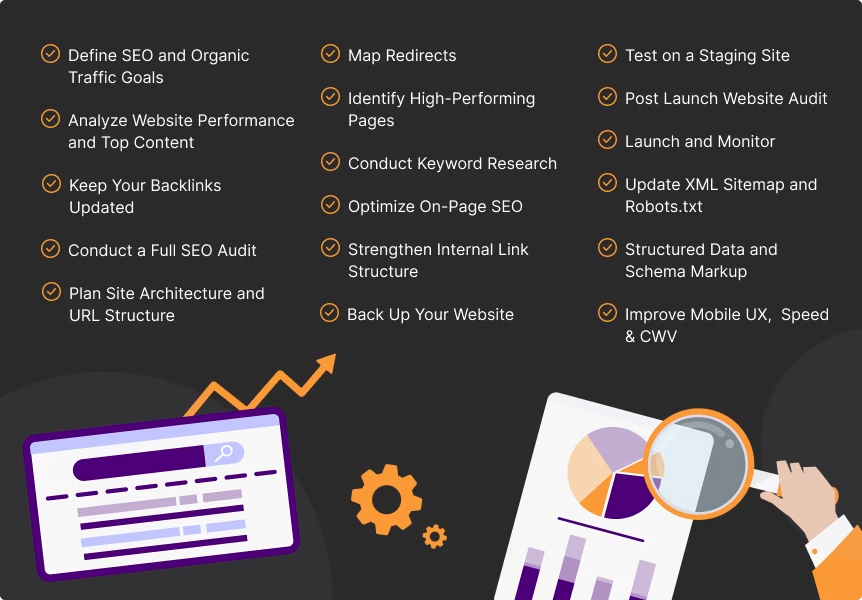
Website redesigns are a natural part of business growth. As technology evolves, design trends shift, and user expectations become more demanding, refreshing the look, feel, and functionality of a site is often necessary. Whether you’re rebranding, improving UX, or updating outdated architecture, a redesign can bring serious value to your digital presence.
But there’s a hidden risk: if SEO isn’t tightly integrated into the process, or if it’s rushed or disconnected from your existing performance data, it can undo years of digital progress in a single stroke. We’re talking about lost rankings, sudden drops in organic traffic, and content that quietly disappears from Google’s radar.
So, is it possible to redesign your website without killing your SEO? Absolutely. This article walks you through exactly what you need to know to avoid costly SEO pitfalls and ensure your next redesign leads to improvements across the board: visually, technically, and strategically.
Key Steps to Redesign Without Losing SEO

Before we dive into the full process, here’s a quick overview of the essential actions you’ll need to take to protect your SEO during a website redesign:
- Audit your current site to identify top-performing pages and SEO issues.
- Set clear SEO goals before design work starts.
- Keep or redirect all important URLs with a detailed mapping plan.
- Don’t redesign pages that already rank well without a clear reason.
- Use staging environments to test everything – then re-audit post-launch.
- Optimize speed, mobile performance, and structured data.
- Monitor rankings and traffic closely after launch and adapt quickly.
Why SEO Should Be a Priority During Redesign
Search engines are still one of the most consistent and cost-effective ways to bring qualified visitors to your website. If SEO isn’t prioritized during a redesign, you risk breaking what’s already working: losing visibility, rankings, and the traffic tied to them.
A redesign isn’t just about how things look; it’s also about how search engines interpret your site structure, content, and performance. When SEO is baked into the process from the beginning, your new site can do more than look better – it can perform better, too.
SEO and Website Redesign: What’s at Stake?
According to HubSpot, 38% of users will stop engaging with a website if the content or layout is unattractive. That’s a compelling reason to improve your visuals. But what happens if you lose visibility in search just as your new design launches?
The traffic that fuels your conversions, bookings, and brand awareness comes largely from organic search. That traffic is earned over time through consistent SEO efforts. A poorly executed redesign can wipe out ranking equity, bury your top-performing pages, and tank your discoverability.
So how do you redesign without sacrificing your search presence? Let’s break it down phase by phase.
Before the Website Redesign: Set the Foundation

Before jumping into a redesign, it’s critical to understand what’s working (and what’s not) on your current site. Laying a solid SEO foundation early helps protect your rankings and ensures smarter decisions throughout the redesign process.
1. Define SEO and Organic Traffic Goals
You can’t improve what you haven’t defined. Before touching a single pixel of your new design, you need to establish what success looks like.
Are you aiming to increase organic traffic by 20% in the next quarter? Lower bounce rates on high-intent pages? Improve keyword rankings for services that drive revenue? These aren’t just nice-to-haves – they’re the benchmarks you’ll use to measure whether the redesign actually moved the needle or simply made the site look better.
Set clear, measurable goals and make sure your web design agency and SEO specialists are working from the same playbook. Aligning on SEO objectives from day one gives your team direction and creates a foundation for smarter decisions. Without that clarity, you risk ending up with a polished site that underdelivers where it matters most: visibility, conversions, and search performance.
2. Analyze Current Website Performance and Top Content
Before tearing your website down to the studs, you need to understand what’s already doing the heavy lifting. Use tools like Google Analytics, Search Console, Ahrefs, or SEMrush, not for vanity metrics, but to uncover which pages are actually driving results.
- Identify high-traffic pages: Which ones bring in the most users?
- Find pages with strong backlink profiles: Which are attracting quality inbound links?
- Analyze user behavior and flow: Where are visitors spending time, dropping off, or converting?
- Pinpoint conversion hotspots: What pages consistently turn traffic into leads?
Let performance dictate priority. Use the insights to decide which pages need refining, which need a rebuild, and which should stay exactly as they are. This data reveals which parts of your site are holding up your SEO foundation. You’re not starting over – you’re building on what works.
3. Conduct a Full SEO Audit
Before jumping into redesign mode, you need to get a forensic look at the current state of your site. This isn’t just box-ticking – it’s how you prevent avoidable SEO disasters.
Run a full crawl using tools like Screaming Frog, Sitebulb, or any solid site auditing software to surface the stuff that quietly chips away at performance. Here’s what you’re looking for:
- Broken links: Dead ends frustrate users and search engines, so fix them before they drag your site down.
- Thin content: Pages with little to no value can dilute your site’s overall authority.
- Slow-loading pages: Site speed directly impacts rankings and user experience – identify what’s slowing things down.
- Redirect chains: Too many redirects waste crawl budget and hurt performance.
- Meta tag issues: Duplicate or missing title tags and meta descriptions confuse Google and weaken your on-page optimization.
Document everything you find. This audit isn’t just a checklist – it’s your baseline. It tells you what needs fixing, what’s worth preserving, and what should be scrapped. Think of it as your SEO health report – something that should be stored in an accessible location so everyone involved in the redesign can reference it throughout the project.
4. Back Up Your Website
This isn’t optional. Before anything changes, make a full backup of your website. That means your content, database, media files, and yes, your URL structure too. You need a clean, complete version of the site exactly as it stands.
Why does this matter? Because redesigns can go sideways. Plugins clash. Pages disappear. Developers hit “publish” before QA is done. Having a full backup means you can roll back instantly if something breaks or ranks nosedive.
Also, and this is where a lot of businesses slip, don’t take your live site down just because a redesign is in progress. Keep it online and functional while your new version is being tested in a staging environment.
Search engines still need to crawl your content. Visitors still need a working experience. You don’t want to lose SEO equity just because the design team is busy behind the curtain.
During the Website Redesign: Build Smart

Now that the groundwork is in place, it’s time to move into the actual redesign. This is where strategic planning meets execution and where SEO can quietly make or break the whole project.
1. Plan Site Architecture and URL Structure Carefully
A clean, logical site structure isn’t just good UX – it’s foundational for SEO. Resist the urge to reinvent every URL just to match the new design aesthetic. Every change comes with a cost.
In this phase, focus on the following:
- Keep your current URL structure where possible
- Use short, descriptive slugs (avoid unnecessary parameters)
- Maintain a clear content hierarchy
- Ensure all pages are easily crawlable and discoverable
If you absolutely must restructure URLs, create a detailed mapping document that pairs each old URL with its new destination.
2. Map Redirects and Maintain Link Equity
No SEO-focused redesign skips this step. A single broken redirect chain can disrupt the flow of authority and cause ranking drops.
Here’s what to prioritize during this stage:
- Use permanent 301 redirects, not 302s
- Avoid redirect loops or sending users through multiple jumps
- Update internal links to point directly to new URLs – don’t let internal navigation rely on redirects.
A full redirect plan should be in place before launch, and tested thoroughly after.
3. Identify and Protect Your High-Performing Pages
Some pages are doing the heavy lifting for your SEO and lead generation – keep them intact.
These include:
- Service pages with strong rankings
- High-traffic blog posts
- Lead magnets or evergreen content with backlinks
Flag them early, keep their URLs unchanged if possible, and preserve their on-page content structure and meta data.
4. Make Minimal Changes to Pages That Rank Well
Pages that already rank well should be handled with care. A visual polish is fine, but resist the urge to rewrite copy or overhaul layout just for aesthetics.
At this point, your attention should be on the following:
- Keep original title tags and meta descriptions where effective
- Maintain keyword focus and content structure
- Avoid disrupting internal linking patterns.
Small tweaks can have big consequences – when in doubt, test on staging first.
5. Conduct Keyword Research Again
A redesign is a good excuse to revisit your keyword strategy. Your audience’s needs may have shifted, and your site’s content should reflect that.
Key actions to take in this phase include:
- Recheck keywords that already rank: are they still relevant?
- Identify new opportunities based on updated services or user intent
- Look for long-tail queries you can naturally target with added content.
Use this insight to guide both page creation and optimization – it’s your roadmap for SEO improvements post-redesign.
6. Optimize On-Page SEO Elements for Visibility
Every new or redesigned page needs to be SEO-ready from the start. This helps search engines and humans understand your content at a glance.
These are the critical steps to get right now:
- Craft unique, relevant title tags and meta descriptions
- Use one clear H1 per page
- Build a logical heading structure (H2, H3, etc.)
- Add descriptive alt text to images
- Optimize URLs for clarity and keywords
And now that the content’s optimized, let’s make sure it’s well-connected internally.
7. Strengthen Internal Link Structure to Support It
You’ve optimized each page, but how do you make sure search engines find them all? That’s where smart internal linking comes in. Internal linking is what ties your SEO efforts together – both for usability and crawlability.
Now’s the time to zero in on these essentials:
- Preserve anchor text consistency
- Link between related content to reinforce topical authority
- Use descriptive anchor text, not “click here”
During redesign, it’s common for links to break or get dropped, so make sure to review thoroughly before launch.
8. Keep Your Backlinks Updated and Tracked
Internal links help users move within your site, but backlinks from other websites help users (and search engines) discover it in the first place. So preserving that external equity helps maintain domain authority and ensures your most valuable links stay active.
Here’s what to prioritize during this phase:
- Identify high-value inbound links (use Ahrefs or SEMrush)
- Make sure those URLs are preserved or properly redirected
- Reach out to referring domains with updated links when needed.
Losing the benefit of those links due to changed URLs is a mistake you can’t afford.
9. Optimize For Mobile and Responsive Design
Mobile-first indexing isn’t optional. According to Hostinger, websites that load in one second convert three times better than those that take five.
Your priorities during this phase should be:
- Design for responsiveness across devices
- Eliminate intrusive pop-ups or elements that don’t scale well
- Simplify navigation for thumb-friendly UX
If your redesign isn’t built with mobile performance in mind, you’re handing rankings to your competitors.
10. Optimize Your Site’s Page Speed and Core Web Vitals (CWV)
A mobile-friendly layout sets the stage, but speed and performance metrics determine whether users stick around. Speed affects everything: rankings, user satisfaction, bounce rate.
Focus on the following key areas at this stage:
- Aim for under 3 seconds load time
- Compress images and use modern formats (WebP, AVIF)
- Implement lazy loading and efficient caching
- Optimize CWV metrics: Largest Contentful Paint (LCP), First Input Delay (FID), and Cumulative Layout Shift (CLS)
Use PageSpeed Insights and Lighthouse to test and refine performance before launch.
Post-Redesign: Validate and Monitor

Once the new design is live, the real test begins. This phase is about validating that everything functions as intended and ensuring your hard-earned SEO doesn’t slip through the cracks.
1. Test on a Staging Site First
Before anything goes live, replicate your site in a staging environment. This is where the team can safely review the full structure, content, forms, and technical elements, without affecting the live site.
Click every link. Submit every form. Browse like a user would. Catch broken paths, missing assets, or incorrect metadata before your audience does.
2. Perform a Post Launch Website Audit
Once the new site is live, it’s time to re-crawl everything. Run a full audit using tools like Screaming Frog, Ahrefs, or Sitebulb.
What you’re looking for:
- Crawl errors or broken links
- Duplicate or missing meta tags
- Issues with page speed or Core Web Vitals
- Inconsistent or lost canonical tags
- Redirects behaving as expected
Treat this audit as a side-by-side comparison to your pre-launch crawl. Anything critical that slipped through the cracks? Fix it fast. This audit is how you validate that all those careful SEO efforts made it across the finish line intact.
3. Launch and Monitor With Intention
Once the post-launch audit confirms your technical health, don’t step away just yet. This phase is about active observation and quick response.
Set up alerts in Google Search Console and Analytics. Keep an eye on ranking shifts, crawl errors, and traffic trends. Use annotations in GA4 to mark the launch date for future reference.
If anything major dips, like a core service page dropping off the map, you want to catch it immediately. Schedule a check-in one week, two weeks, and one month after launch. Consistent performance signals success. Sudden traffic drops need investigating.
4. Update Your XML Sitemap and Robots.txt
Your sitemap should reflect every live, indexable page of the redesigned site. Submit the updated sitemap in Google Search Console immediately after launch.
Don’t forget to check the robots.txt file. If you used staging blocks (like Disallow: /) during development, make sure they’re removed. This happens more often than you’d think and it tanks visibility.
5. Structured Data and Schema Markup
After you’ve ensured search engines can access and crawl your new structure, it’s time to help them better understand what your site is about. That’s where structured data comes in.
Review your structured data to ensure:
- Business info (LocalBusiness schema) is accurate
- Articles, FAQs, and service pages use appropriate markup
- Events, reviews, or products are tagged correctly.
Search engines love context, and schema provides it. Valid schema can boost your presence in rich results, improve CTR, and help bots better understand your new structure. Use tools like Google’s Rich Results Test or Schema Markup Validator to verify implementation.
Website Redesign SEO Checklist
Before launching the redesigned website, you need to make sure to:

Avoid These Redesign SEO Mistakes

Even with SEO on the checklist, some missteps still manage to sneak into the redesign process and they can quietly wipe out your rankings.
Here are the most common mistakes that tend to sabotage SEO during a website redesign:
- Failing to redirect old URLs properly
- Switching domains without a clear SEO transition plan
- Removing high-value content or key landing pages
- Blocking search engines with misconfigured robots.txt files
- Accidentally allowing staging sites to get indexed
- Skipping pre- and post-redesign performance tracking
- Ignoring mobile responsiveness
- Losing on-page keyword targeting during content edits
- Overlooking changes that hurt Core Web Vitals or page speed.
From what we’ve seen at Ginger IT, a handful of issues show up consistently, often with a noticeable impact on traffic and visibility. Avoiding these pitfalls isn’t complicated, but it does require focus.
Our SEO Redesign Process in Action

We’re currently in the middle of a major website redesign for a client in the medical sector. Since the client already enjoys strong search rankings and steady traffic, they were fully briefed on the SEO risks that come with redesigning an established site.
One of the biggest complexities is that this isn’t just a visual refresh – we’re also making substantial changes to the site’s content. The new version will include several times more pages than before, and much of the existing content has been significantly updated.
Before development began, we conducted a full SEO audit using Screaming Frog and SEMrush to identify high-performing pages, top keywords, and backlinks worth protecting. We then manually mapped over 120 existing URLs to their new destinations using 301 redirects to preserve link equity and prevent ranking losses.
During staging, we used Google Search Console’s URL Inspection Tool to check for indexing issues and monitored metadata, page speed, and mobile performance through Lighthouse and GA4. This helped us catch any early regressions and fix them before launch.
Once the redesigned site goes live, we plan to track keyword rankings and organic traffic daily for at least two weeks to spot any dips early and respond quickly. While some short-term fluctuation is expected, we’re confident that by following SEO best practices throughout the process, any disruption will be minimal and the long-term gains will be significant. As Tim Cameron noted, aim to minimize any negative ranking impact and in many cases, a well-planned site rebuild can actually lead to an SEO boost once the new version goes live.
Final Thoughts
A well-executed redesign has the power to elevate your brand, improve usability, and drive better business outcomes. But when SEO is overlooked, the fallout isn’t always loud, it creeps in quietly, often showing up as a steady decline in traffic and lost visibility.
SEO and website redesign aren’t opposing forces. They’re two sides of the same coin. When both work in sync, you get a site that’s visible, usable, and built to grow.
Redesigning your website without losing SEO rankings comes down to thoughtful planning, sharp execution, and ongoing oversight. If the goal is to maintain visibility while enhancing user experience, SEO needs to be part of the process from day one, not an afterthought.
To get the best outcome, choose a team or agency that combines both design and SEO expertise from the beginning.
Partner With a Web Design Agency That Knows SEO
Many redesigns fail not because of poor design, but because SEO was never in the room. That’s where partnering with a web design agency like Ginger IT Solutions makes a difference.
At Ginger IT, SEO is baked into our website redesign services. We build websites that do more than look great – they work hard for your business: attract traffic, load fast, and turn visitors into customers. From UX design and content architecture to technical SEO and analytics setup, our approach ensures you get a modern, optimized, conversion-focused site without losing ground on search.
FAQs
1. How do I redesign my site without changing the URL structure?
Keep existing URLs where possible. If changes are needed, set up 301 redirects from old URLs to new ones.
2. What if I have many new pages in the website redesign?
That’s fine, just make sure each page is optimized, adds value, and fits your site structure. Link them internally and update your sitemap to help Google index them quickly.
3. Will redesigning my website hurt my current rankings?
It can if the redesign is done without proper SEO planning. But with thorough audits, strategic redirects, and expert support, you can protect your rankings or even improve them during the redesign process.
4. How do I improve SEO during a redesign?
Run an SEO audit, optimize for mobile and Core Web Vitals, refine content and metadata, and use schema markup. A well-executed redesign can actually boost your SEO.
5. Do website designers do SEO?
Most website designers focus on aesthetics and layout, while effective SEO involves technical setup, content strategy, and performance optimization.

